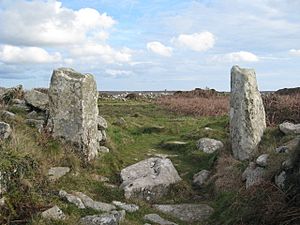Chûn Castle facts for kids

Entrance to Chûn Castle
|
|
| Lua error in Module:Location_map at line 420: attempt to index field 'wikibase' (a nil value). | |
| Type | hill fort |
|---|---|
| History | |
| Periods | Iron Age |
| Site notes | |
| Excavation dates | 1895, 1925, 1927 and 1930 |
Chûn Castle is an ancient hill fort located near Penzance in Cornwall, England. It's a type of Iron Age settlement, like a big, round fortress. This fort was built around 2,500 years ago. It might have been used again later to protect nearby tin mines.
The castle stands next to an old path called the Tinners’ Way. This path was used long ago for moving tin. The name Chûn comes from the Cornish words Chi an Woon. This means ‘the house on the downs’. Today, the area is sometimes called Chûn Downs. A very old stone monument called Chûn Quoit is also nearby.
Contents
What is Chûn Castle?
Chûn Castle is a special type of ancient fort. It was designed with strong defenses. It has both an inner and an outer wall and ditch. These features made it very secure.
In the 1700s, Edward Lluyd studied the fort. He noted its advanced military design. Even today, you can clearly see the remains of these walls. They were once over twenty feet tall. Now, they stand at about five feet. This is because some stones were used for buildings in the 1800s.
Digging Up History: Excavations
Archaeologists have dug at Chûn Castle several times. They did excavations in 1895, 1925, 1927, and 1930. During these digs, they found many pieces of pottery. The oldest pottery dates back to the 4th century BC. This pottery looks similar to ancient pottery found in Brittany, France.
It's possible the fort was built on an even older site. Nearby, Chûn Quoit is much older, from around 2400 BC. The fort was likely not used around the 1st century AD. But it was reoccupied and changed later, possibly until the 6th century. It might also have been used during the later Roman period.
Why Was the Fort Built?
People think Chûn Castle was built to protect valuable resources. The area around it, like Pendeen, was rich in tin and copper. Places like Geevor Tin Mine show how important mining was. Iron and tin waste materials were found inside the castle. This suggests metalworking happened there.
The fort's location was also very strategic. It overlooks the Celtic Sea to the north. It also had a view of the land route to the West Penwith peninsula. This strong position and design suggest it was used for military purposes. It was likely a key defense point.
The Ancient Well
Inside the castle's inner walls, there is a well. This well is quite remarkable. It once had steps leading down to the water. Even during dry weather, the well still has water. Local people used water from this well until the 1940s. They used it for everyday needs.
Some people also believed the well had special powers. They thought its water could give them eternal youth. Even today, some Neopagans visit the site. They go there on important religious days.

